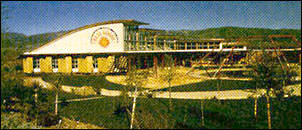Western Exposure
A Northern California Sustainable Energy Showcase Revolves Around the Sun
It’s only been a few generations since many of us moved from agricultural societies to lives lived mostly indoors. This radical shift, which occurred with the Industrial Age, has severed our vital connection to the days and seasons. Perhaps that’s why visitors to the Solar Living Center, a 13-acre sustainable-energy demonstration site in northern California, feel so renewed: It returns our attention to the natural world, which, as it turns out, makes people feel good.
Built by the Real Goods company of Ukiah, California to show off its sustainable technology products, the Solar Living Center is fundamentally different from most Western commercial projects. That difference began with the decision to design the grounds first, before starting on the main building. And unlike Western buildings where the physical and spiritual center is the living room or entranceway, the center’s focal point is a wide, shallow pool and fountain.
The main building, a tall, gracefully curving one-story structure, is one of the largest strawbale constructions in the world. The strawbales, which provide excellent insulation, are made with mold-resistant rice straw that would otherwise be burned as waste by U.S. rice farmers. The bales are covered with soil and cement.
A central fountain with a drip ring for evaporative cooling provide the first line of defense against the 100-degree-plus summer days. Overhangs and manually controlled hemp awnings allow heat to escape, and solar-powered evaporative coolers flush the building with cool air at night. A south-facing glass wall provides all of the building’s lighting needs and most of its heat. The Solar Living Center is hooked up to the power grid, but its managers must get immense satisfaction at bill time: It ends up selling more energy to the utility company than it buys.

